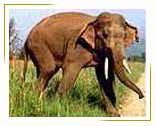 A grand old tusker trundling through the forests can be an awe-inspiring sight, and the biggest of all land animals, the Indian Elephant doesn’t need to do much to attract attention! An average Indian elephant is anything between 2.4 m to 3 m tall, and weighs anything between 3,600 kg to 5000 kg! It also requires about 200 kg of green fodder, and due to dwindling habitat areas, there has been a drastic fall in their numbers. They are now an endangered species. A grand old tusker trundling through the forests can be an awe-inspiring sight, and the biggest of all land animals, the Indian Elephant doesn’t need to do much to attract attention! An average Indian elephant is anything between 2.4 m to 3 m tall, and weighs anything between 3,600 kg to 5000 kg! It also requires about 200 kg of green fodder, and due to dwindling habitat areas, there has been a drastic fall in their numbers. They are now an endangered species.
There are only two elephant species left in existence, the African Elephant, and the Asian or Indian Elephant. The African species are bigger then the Indian one. Elephants live in a matriarchal society that are led by females in herds of 3 to 10, with 2-3 mature cows, calves and sub-adults all moving together from place to place in search of food. Adult males are separated from the herd as a protection against inbreeding. The gestation period of elephants is very long, from between 19 to 21 months, and hence the birth rate is low. Also, there has to be a minimum interval of four years between two calves, and so the growth rate of the population is slow too. However, the life expectancy of an Indian Elephant is 70 to 80 years, and they are versatile creatures that adapt to diverse living conditions.
The elephant population is vulnerable to unscrupulous poachers due to their precious ivory tusks. Elephant tusks can weigh up to 22 kg a pair. Elephants feed on barks, roots, fruit and grasses. The elephant population is now part of the Elephant Project, a nation wide conservation effort to protect these lumbering beasts from extinction. Manas, Corbett, Dalma and Palamu, Bandipur and Nagarhole, Periyar and Madumalai are the best places to watch the Indian Elephant in its natural habitat.
| 

